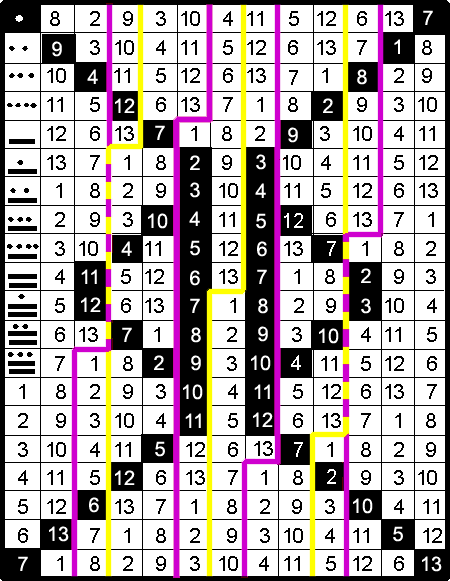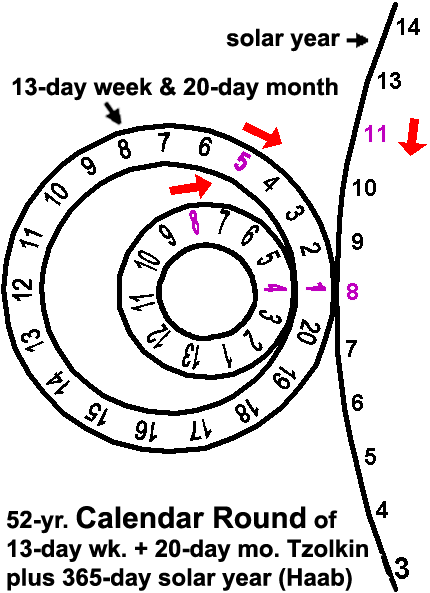

| and the… |  |

The Mayan Calendar
The Tzolkin, Haab, Calendar Round, and the Mayan Long Count, in relation to the Cycles of History

I: THE MAYAN CALENDAR points to the next page in this section that lists some of the different segments and counts of various Mayan calendars.
II: KALARHYTHMS and MAYA points to a page in this section that offers a brief comment on the correlation and possible connection between KalaRhythms and the Mayan Calendar.
III: THE 52-YR. SPIRITUAL CYCLE points to the 52-year Spiritual Cycle of KalaRhythms in the United States. This is the fourth KalaRhythm (after the Physical, Emotional & Intellectual Cycles.
IV: INTRO. TO KALARHYTHMS is quick reference to the general theory of KalaRhythms.

Kalarhythms & the

The Mayan Calendar
Mayan Calendar Durations

The Serpent
Earth / East

The Dog
Air / North


The Eagle
Water / West

The Solar Lord
Fire / South
Tzolkin = 260 days = 20 wks. = 13 mos.
13-day wk., 20-day mo., 52-dy. 1/5, 65-dy. qtr.


| Mayan Calendar Counts | |||
| ( 1 kin = 1 day ) | Mayan Numerals |
||
| time cell = | 4 kin | ||
| wave spell | 13 kin | ||
| vinal = | 20 kin | ||
| castle = | 52 kin | ||
| Tzolkin = | 260 kin | ||
| tun = | 360 kin | 5k vayeb = 365k haab | |
| vayeb = | 5 kin | ||
| haab = | 365 kin | ( 1 tun = 360 kin ) | |
| tun = | 360 kin | 1 tun | yrs.+/- < 1 |
| holtun = | 1,800 kin | 5 tun | < 5 |
| Cal.Rnd.qtr. | 4,680 kin | 13 tun | > 13 |
| katun = | 7,200 kin | 20 tun |
< 20 |
| Cal.Round | 18,980 kin | 73 tzolkin | < 52 |
| Ahaw = | 93,600 kin | 260 tun 13 katun |
> 256 |
| baktun = | 144,000 kin | 400 tun 20 katun |
> 394 |
| Long Count (Great Yr.) |
1,872,000 kin | 5,200 tun 13 baktun 20 Ahaw 260 katun |
> 5,125 |
| pictun = | 2,880,000 kin | 8,000 tun 20 baktun |
> 7,885 |
calabtun = |
57,600,000 kin | 160,000 tun 20 pictun |
> 157,704 |
kinchiltun= |
3.2 mil. tun 20 calabtun |
> 416,162 | |
| alatun = | 64 mil. tun 20 kinchiltun |
>63,080,082 | |
The Calendar Round takes 52 years for the same week day, month day and haab day to realign together (18,980 kin). A Tun has 360 kin, almost a solar year. To complete the 365-kin year, they added a 5-kin Vayeb at year’s end for a 365-Haab.
Hence 400 tun (or 20 x 20 tun) = 20 katun = 1 baktun.
The Tzolkin has 260 days/kin = 20 weeks (13 kin each) = 13 months (20 kin each). Its 13 columns for weeks and 20 rows for months form a time matrix. The first day of each 13-day week falls on a different row for 20 times, then it begins a new Tzolkin.
Hence 13 x 20 kin = 260-kin Tzolkin.
The Ahaw Cycle has 260 tun = 20 Calendar Round Qtrs. = 13 katun (= 7,200 weeks = 46,800 months = 360 Tzolkins). It is just more than 256 years (93,600 kin). The Ahaw cycle is a greater fractal of the 260-unit Tzolkin matrix that substitutes tun for kin.
Hence 13 x 20 tun = 260-tun Ahaw.
The Long Count has 260 katun = 20 Ahaw = 13 baktun = 52,000 tun, (= 7,200 Tzolkins = 93,600 months =144,000 weeks). It is just more than 5,125 years (1,872,000 kin). It too is a greater fractal of the Tzolkin that substitutes katun for tun.
Hence 13 x 20 katun = 260-katun Long Count.
The Mayan Calendar Date is written with a five-decimal count to show a day’s position within the; baktun (400 tun), katun (20 tun), tun (360 kin), vinal (20-kin month), and the kin. The Great Year has 13 baktun, so we write 13.0.0.0.0 for day one, and, for example, 12.9.6.1.0 for January 1, 2000.
The Long Count Cycle will end in Dec. 21, 2012 when it will again be 13.0.0.0.0, according to anthropologists who begin our current Count of just more than 5,125 years from in Aug. 31, 3113 B.C.
All text is original (unless otherwise marked), please reference this site when quoting.
Use of images without prior expressed permission is prohibited.